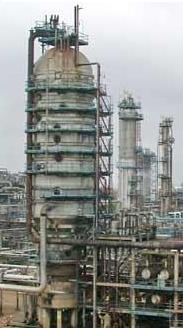Distillation Towers
Distillation Towers are closely related to Silos, but are distinguished by their truly impressive digestive systems and intricate food webs. A mature Distillation tower will spend practically its whole life eating, and its solid waste and exhalations create fertile feeding grounds not just for other towers, but also for all kinds of different structons. For example, nearly all vessels rely on the assorted waste products of Distillation towers in oil refineries. Where richer foods are abundant, an ecosystem may feature many Distillation towers feeding of each other's waste products in succession - truly a spectacular sight for turrisologists and hobbyists alike!External Anatomy
- Pump: the mouth of a Distillation tower, this organ is responsible for the initial ingestion of the individual's preferred food.
- Preheater: a sort of salivary gland which heats the food to just below the desired temperature in the stomach.
- Reboiler: located below the stomach, this organ helps filter out undigested vapors from the heavier waste product by reheating partially digested food and returning it to the stomach.
- Condenser: as vapors digest, they move through an intestine and cool, returning to a liquid form.
- Accumulator: underneath the condenser, partially digested and cooled waste products build up. Some of this matter is reintroduced to the stomach as external reflux, while the portion that has been fully digested moves on.
Internal Anatomy
An individual Distillation tower will have its own highly specific ideal body temperature, and its health will rapidly decline should it be unable to stay within that small range. Generally speaking, the tower will be warmest just below the stomach, where the reboiler helps to keep up the optimum heat, while the top of the tower is cooled with help from the refluxing instruments around the condenser and accumulator. In addition to these exacting temperature needs, an individual will also have its own preferred biofluid pressure, which varies depending on its diet. The biofluid pressure in the stomach is typically slightly lower than in the external organs, which helps initiate the digestion process as food moves from the preboiler to the flash zone, or middle segment of the stomach. Above the flash zone is the rectification section, where lighter vapors are digested, and below the flash zone is the stripping section, where heavier matter is digested. These sections are separated by membranes bordered by weirs, which hold food in small pools as it moves up and down through the stomach. Distillation towers can feature a number of different membrane structures, some of which are listed here.
- Sieve: as food moves up and down through the stomach, it passes through lightly perforated membranes that allow heavier matter to drip down while lighter vapors rise up and heat the membrane above. Many Distillation towers will have 50 or more of these membranes!
- Bubble Cap: similar to the sieve structure, bubble cap membranes add a small pipe-and-dome structure above each perforation, helping to aerate the food as it digests and improving heat transfer between membrane layers.
- Pack: unlike the many fine membranous layers of a sieve or bubble cap tower, pack towers compress their food into larger sections, which are digested with the help of a number of gastroliths. These gastroliths vary widely in material, shape, and size based on the tower's diet, but common desired features seem to be a large surface area and a nonreactive shell, such as copper Raschig rings or Berl saddles.
